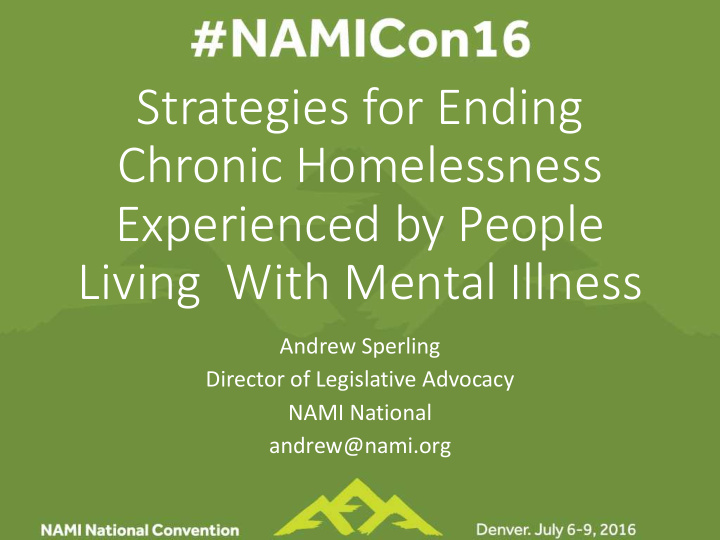



Strategies for Ending Chronic Homelessness Experienced by People Living With Mental Illness Andrew Sperling Director of Legislative Advocacy NAMI National andrew@nami.org
Where do Non-Elderly People With Mental Illness Live? • Number of people with mental illness experiencing chronic homelessness??? • 362,163 homeless in HUD most recent “Point in Time” count • 85% of the chronic population in many US cities • In Emergency Shelters: 180,000 adults with disabilities • HUD “Worst Case” Housing Needs Report: 1.31 million non - elderly adults renters with disabilities with very low incomes in 2011: • Paying more than 50% of income for rent and/or • Living in seriously substandard housing • In Institutions: 412,000 adults age 31-64 in nursing homes; 40,000 in state psychiatric hospitals; • In Adult Care Homes, Large Group Homes, Assisted Living ???
SSI Beneficiaries are Poor • In 2014: • 4.9 million non-elderly persons with disabilities received SSI • Federal SSI -- $726/month & $8,714/year • Federal Poverty Level (1 person) -- $931/month & $11,170 • 21 States provided state-funded supplements to SSI for non-elderly people living in the community • Supplements ranged from $5(NE) to $362 (AK)
Priced Out in 2014 Study • http://www.tacinc.org/knowledge-resources/priced-out-findings/ • The average income of a single individual receiving SSI payments was $8,995 annually or $750 per month • National average rent for a modest one-bedroom rental unit was $780 • equal to 20.1% of the national median income for a one-person household • 23% below the 2014 federal poverty level • In 2014 it was virtually impossible for a single adult receiving SSI to obtain decent and safe housing in the community without some type of rental assistance • On average nationally, a person receiving SSI had to spend: • 104% of monthly income to rent a modest one-bedroom housing unit • LOWEST: (TN and OK) = 60% • HIGHEST: Honolulu (HI) = 191% • 90% of monthly SSI to rent a studio unit • In eight states and DC - the average studio/efficiency rent exceeded 100% of the income of an SSI recipient.
SSI Income • SSI Benefits 19% of Median Income 50% of Median Income 30% of Median Income
HUD Rent Subsidy Programs Addressing the “Affordability Gap” • Public housing units =1.1 million units (affect of “elderly only” housing policies) • Only 16% assist people with disabilities • HUD “Assisted Housing” = 1.2 million units (affect of “elderly only” housing policies) • Only 17% assist people with disabilities • Other programs = 443,000 units • Section 811 = 30,000 units • Homeless programs = 50,000
What is the Solution? Permanent Supportive Housing • 3 Legs of the PSH Stool • Capital (LIHTC) • Operating Subsidy (Section 8 project-based, 811 PRA) • Supportive Services (Medicaid) • PSH improves housing stability, employment, mental and physical health, and school attendance; and reduces active substance use. People in supportive housing live more stable and productive lives. • Cost-Effective: PSH costs essentially the same amount as keeping people homeless and stuck in the revolving door of high-cost crisis care and emergency housing. • Beneficial: PSH helps build strong, healthy communities by improving the safety of neighborhoods, beautifying city blocks with new or rehabilitated properties, and increasing or stabilizing property values over time. • See more at www.csh.org
What is PSH? • It is Permanent • Residents . . . • are tenants; • have leases with full rights of tenancy; • pay rent; and • can keep their apartments as long as they pay their rent and abide by the terms of their leases. • It is supportive: • Supportive services, including • Case management • Clinical social work • Other medical services • Supportive employment • are provided on-site and/or arranged by the service provider. • Rent is subsidized by the local housing agency • Engaging in services is not a condition of tenancy
What PSH is Not • It is not • A group home: In group homes residents share facilities, including bedrooms and baths. Meals are prepared by staff. Residence is at the will of the service provider. Adherence to treatment is a condition of residence. • A nursing home • Nursing homes and group homes lead to dependent living: PSH fosters independent living. • A shelter bed or transitional housing
What Works? Housing First • What is “Housing First”? • Simple expeditious application process, • No requirement for tenant to participate in or complete treatment prior to obtaining structured housing, intensive case management available once housed, • Conditions of tenancy do not exceed normal conditions for other leaseholders • Numerous studies demonstrate cost effectiveness
Funding for the HUD McKinney- Vento Program • FY 2016 • $2.25 billion, $115 million above FY 2015 • $250 million for Emergency Solutions Grant (ESG) program • $1.918 billion for local Continuum of Care (CoC) competition • FY 2017 House T-HUD funding bill (HR 5394) -- $2.487 billion, up $237 million over current level • FY 2017 Senate T-HUD funding bill (S 2844) -- $2.3 billion
What Can You Do? • Get involved in your local HUD Continuum of Care • https://www.hudexchange.info/grantees/?grantees action=main.searchresults&programid=3 • Participate in the “ ConPlan ” planning process for your state and local housing and community development agencies – state HFA, local PHA • More information at: • www.naeh.org • www.tacinc.org • www.csh.org
Recommend
More recommend